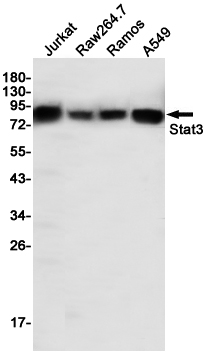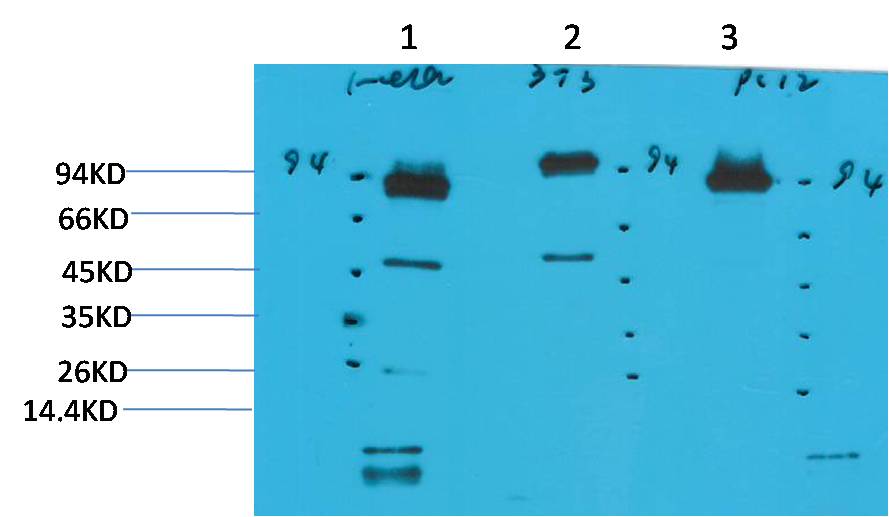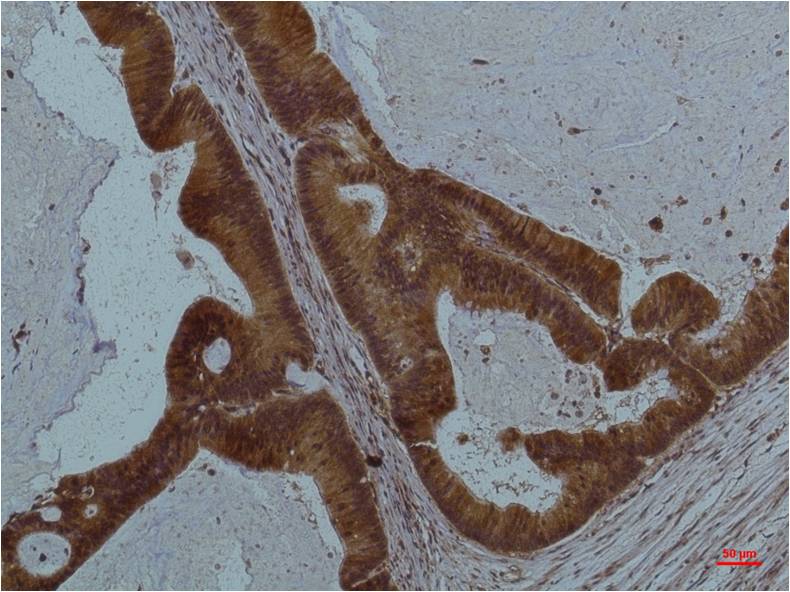-
Product Name
Anti-STAT3 (6H10) Mouse antibody
- Documents
-
Description
STAT3 (6H10) Mouse monoclonal antibody
-
Tested applications
WB, IHC-P
-
Species reactivity
Human, Rat, Mouse
-
Isotype
Mouse IgG1
-
Preparation
Antigen: Purified recombinant protein expressed in E.coli.
-
Clonality
Monoclonal
-
Formulation
PBS(pH 7.4) containing with 0.02% sodium azide and 50% glycerol.
-
Storage instructions
Store at 4°C short term. Store at -20°C long term. Avoid freeze / thaw cycle.
-
Applications
WB: 1/1;000-2;000
IHC: 1/100-200
-
Validations

Western blot detection of Stat3 in Jurkat,Raw264.7,Ramos,A549 cell lysates using Stat3 (6H10) Mouse mAb(1:1000 diluted).Predicted band size:79, 86KDa.Observed band size:86KDa.

Western blot analysis of 1) Hela, 2)3T3, 3) PC12 with STAT3 Mouse mAb diluted at 1:2,000.

Immunohistochemical analysis of paraffin-embedded Human Colon Caricnoma usingSTAT3 Mouse mAb diluted at 1:200... Immunohistochemical analysis of paraffin-embedded Mouse Brain Tissue usingSTAT3 Mouse mAb diluted at 1:200.
-
Background
Swiss-Prot Acc.P40763.Signal transducer and transcription activator that mediates cellular responses to interleukins, KITLG/SCF, LEP and other growth factors (PubMed:10688651, PubMed:12359225, PubMed:12873986, PubMed:15194700, PubMed:17344214, PubMed:18242580, PubMed:23084476). Once activated, recruits coactivators, such as NCOA1 or MED1, to the promoter region of the target gene (PubMed:17344214). May mediate cellular responses to activated FGFR1, FGFR2, FGFR3 and FGFR4 (PubMed:12873986). Binds to the interleukin-6 (IL-6)-responsive elements identified in the promoters of various acute-phase protein genes (PubMed:12359225). Activated by IL31 through IL31RA (PubMed:15194700). Acts as a regulator of inflammatory response by regulating differentiation of naive CD4+ T-cells into T-helper Th17 or regulatory T-cells (Treg): deacetylation and oxidation of lysine residues by LOXL3, leads to disrupt STAT3 dimerization and inhibit its transcription activity (PubMed:28065600). Involved in cell cycle regulation by inducing the expression of key genes for the progression from G1 to S phase, such as CCND1 (PubMed:17344214). Mediates the effects of LEP on melanocortin production, body energy homeostasis and lactation . May play an apoptotic role by transctivating BIRC5 expression under LEP activation (PubMed:18242580). Cytoplasmic STAT3 represses macroautophagy by inhibiting EIF2AK2/PKR activity (PubMed:23084476). Plays a crucial role in basal beta cell functions, such as regulation of insulin secretion .
Related Products / Services
Please note: All products are "FOR RESEARCH USE ONLY AND ARE NOT INTENDED FOR DIAGNOSTIC OR THERAPEUTIC USE"
